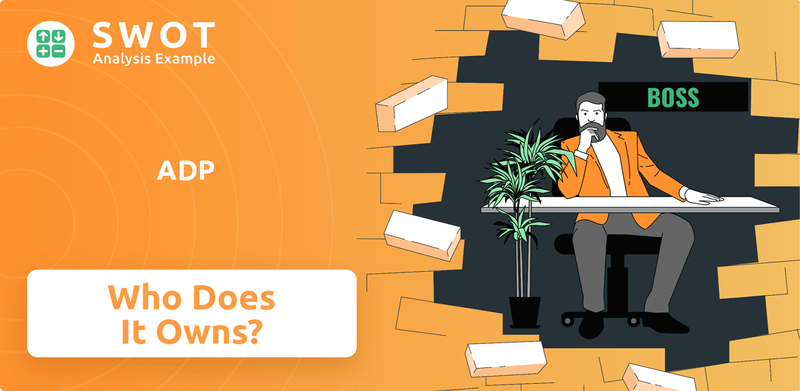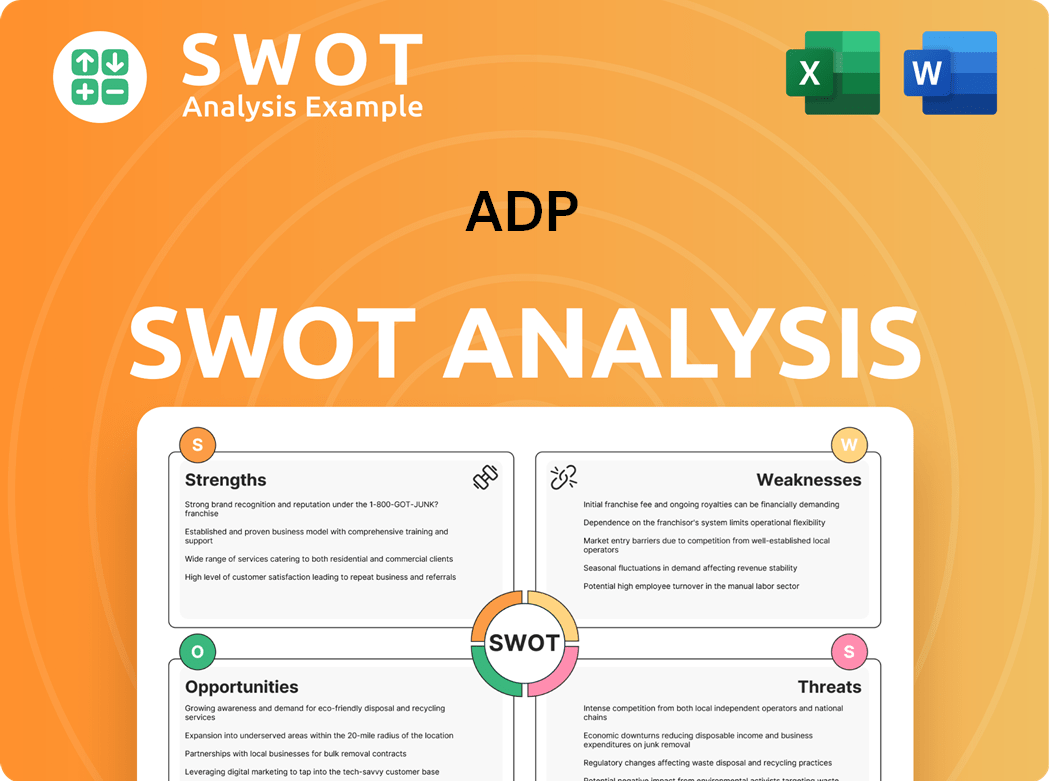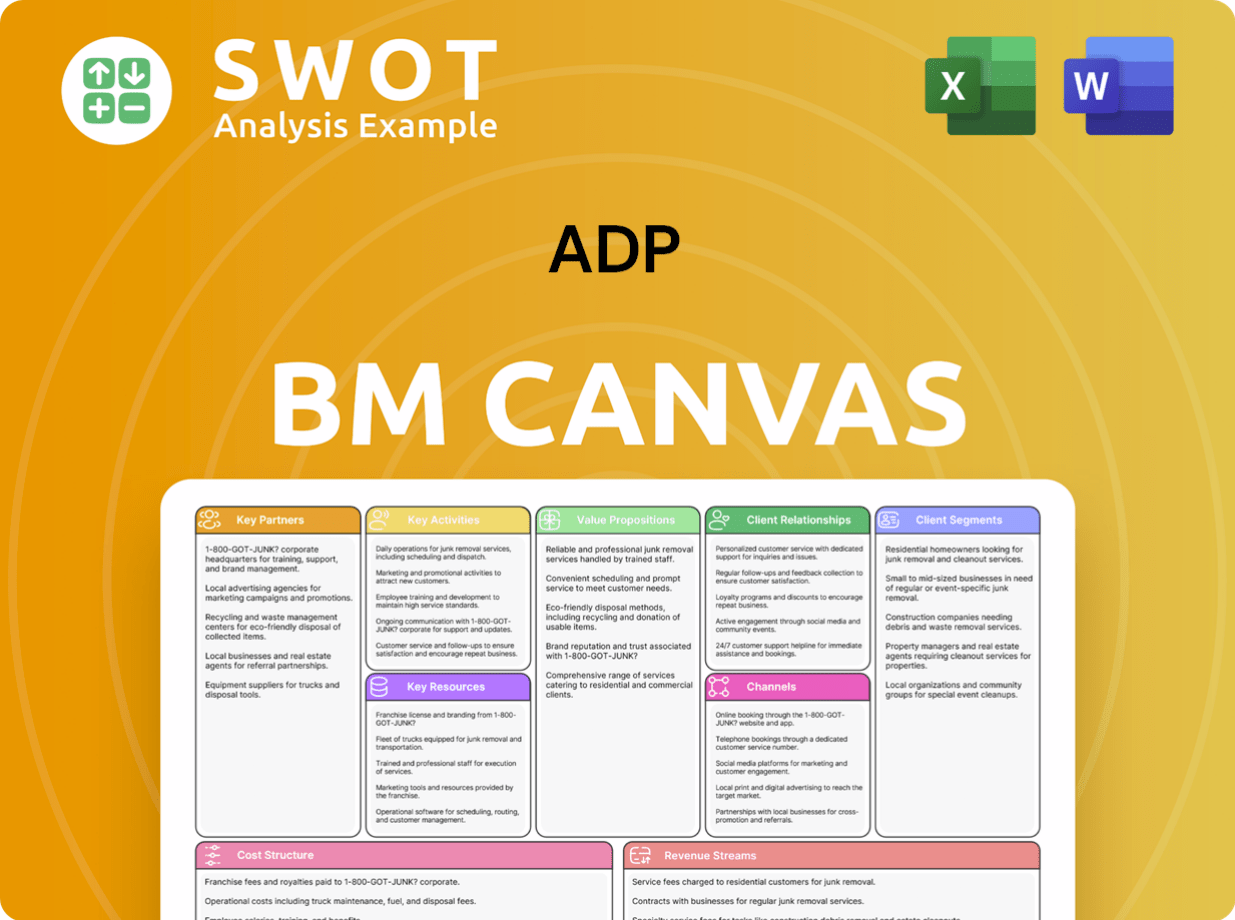ADP Bundle
Who Really Controls Automatic Data Processing (ADP)?
Understanding a company's ownership is key to grasping its future. From its humble beginnings as Automatic Payrolls, Inc., to its current status as a global HCM leader, ADP's ownership has transformed dramatically. This exploration will unravel the complex ADP SWOT Analysis, revealing who truly holds the reins of this financial powerhouse.

Delving into the ADP company ownership structure is critical for investors and stakeholders alike. Knowing who the major shareholders are, and understanding the board of directors’ influence, provides insights into the strategic direction of ADP stock. This analysis will explore ADP's history, its current market capitalization, and the evolution of its ownership since its initial public offering, offering a comprehensive ADP company profile and background.
Who Founded ADP?
The story of Automatic Data Processing (ADP) began in 1949. It was founded by Henry Taub, initially as Automatic Payrolls, Inc., in Paterson, New Jersey. The company started as a manual payroll processing business.
Henry Taub launched the company with his own funds and a small loan. His brother, Joe Taub, soon joined him. Frank Lautenberg became a key partner in 1952, bringing sales and marketing expertise. Lautenberg became a full partner by 1957. This early partnership structure was crucial to the company's initial growth.
In its early days, ADP focused on manual payroll processing. Details about the exact equity split among the founders at the beginning are not publicly available. In 1961, the company changed its name to Automatic Data Processing, Inc. (ADP) and went public. This marked a significant turning point for the company.
Henry Taub founded ADP, originally named Automatic Payrolls, Inc., in 1949. The company started as a manual payroll processing service.
Joe Taub, Henry's brother, joined the company soon after its founding. Frank Lautenberg became a key partner in 1952, contributing sales and marketing leadership.
ADP went public in 1961, which provided capital for expansion. At the time of its IPO, ADP had approximately US$400,000 in revenue.
At the time of the IPO, ADP had around 300 clients and 125 employees. The IPO provided capital for technological advancements and expansion. For more details on the company's history, you can read Brief History of ADP. Early agreements, such as vesting schedules or buy-sell clauses, from this initial private phase are not available in public records. As of early 2024, ADP's market capitalization is substantial, reflecting its growth since its early days. The company's current headquarters is located in Roseland, New Jersey. The company's role in human resources and its financial performance have evolved significantly since its founding. ADP's major shareholders and the ADP company ownership structure have changed over time, particularly after the IPO.
The early ownership of ADP involved Henry Taub, Joe Taub, and Frank Lautenberg. The IPO in 1961 was a pivotal moment for the company.
- Founded in 1949 by Henry Taub.
- Frank Lautenberg became a key partner, bringing sales and marketing expertise.
- ADP went public in 1961.
- The IPO helped fund technological advancements and expansion.
ADP SWOT Analysis
- Complete SWOT Breakdown
- Fully Customizable
- Editable in Excel & Word
- Professional Formatting
- Investor-Ready Format

How Has ADP’s Ownership Changed Over Time?
The evolution of ADP's ownership has been shaped by strategic decisions and market dynamics. Initially listed on the American Stock Exchange, ADP transitioned to the New York Stock Exchange in 1970. Further changes occurred in 2007 with the spin-off of the ADP Brokerage Service Group, resulting in Broadridge Financial Solutions, Inc., and in 2014, when CDK Global was spun off, focusing ADP's operations on human capital management. These moves reflect ADP's adaptation to market demands and strategic realignment over time.
The company's ownership structure highlights the influence of institutional investors. This is typical for large-cap corporations. These shifts have influenced ADP's strategic direction and operational focus, as the company has adapted to changing market conditions and business opportunities. For more insights, you can explore the Growth Strategy of ADP.
| Event | Date | Impact on Ownership |
|---|---|---|
| Listing on NYSE | 1970 | Increased visibility and access to a broader investor base. |
| Broadridge Spin-off | 2007 | Reduced ADP's scope, creating a separate entity. |
| CDK Global Spin-off | 2014 | Allowed ADP to focus on human capital management. |
As of March 4, 2025, ADP's ownership is predominantly held by institutional investors, who control approximately 82% of the shares. Vanguard Group Inc. is the largest shareholder, holding around 10% of the shares outstanding, or roughly 40,949,884 shares as of March 31, 2025. Other significant institutional investors include BlackRock, Inc. (8.90% or 36,172,484 shares as of March 31, 2025), State Street Corp (4.60% or 18,594,992 shares as of March 31, 2025), and Geode Capital Management, LLC (2.72% or 11,043,137 shares as of March 30, 2025). The general public holds the remaining 17% of the company's shares. This distribution underscores the significant influence that institutional investors have on ADP's strategic decisions and market performance.
ADP is a publicly traded company with a significant portion of its shares held by institutional investors. This structure influences its strategic direction and market performance.
- Institutional investors hold approximately 82% of the shares.
- Vanguard is the largest shareholder, with about 10% of outstanding shares.
- The general public owns approximately 17% of the company.
- ADP's stock has been listed on the NYSE since 1970.
ADP PESTLE Analysis
- Covers All 6 PESTLE Categories
- No Research Needed – Save Hours of Work
- Built by Experts, Trusted by Consultants
- Instant Download, Ready to Use
- 100% Editable, Fully Customizable

Who Sits on ADP’s Board?
As of March 2024, the board of directors for the ADP company comprised 12 members. The structure emphasizes independence, with 10 out of the 12 directors being independent. The board also reflects diversity, with 41% (5 out of 12) of the directors being women and 25% (3 out of 12) from racially or ethnically diverse backgrounds, including 2 Hispanic/Latino and 1 Black director. The average age of the directors is 61 years.
Key figures on the board include Maria Black, serving as President and CEO. Thomas J. Lynch holds the position of independent, non-executive board chair, effective January 31, 2024, succeeding Carlos A. Rodriguez, who remains a non-employee director. John P. Jones, while transitioning from his role as lead independent director, continues as a board member. Other board members include Peter Bisson, David V. Goeckeler, Linnie M. Haynesworth, Francine S. Katsoudas, and Nazzic S. Keene.
| Board Member | Title | Key Role |
|---|---|---|
| Maria Black | President and CEO | Oversees the company's operations |
| Thomas J. Lynch | Independent, Non-Executive Board Chair | Leads the board's activities |
| Carlos A. Rodriguez | Non-Employee Director | Provides guidance and oversight |
| John P. Jones | Board Member | Contributes to board discussions and decisions |
While the specific voting structure for ADP stock, such as a one-share-one-vote system, isn't explicitly detailed in public information, the substantial institutional ownership, which held 82% of shares as of March 4, 2025, suggests that the board likely considers institutional investor preferences. There have been no recent public reports of proxy battles or significant governance controversies. For more insights on the company's strategic approach, consider reading about the Marketing Strategy of ADP.
ADP's board of directors includes a diverse group of experienced professionals who oversee the company's operations. Institutional investors hold a significant portion of ADP stock. Understanding the board and ownership structure is important for those interested in ADP company ownership.
- The board is predominantly independent.
- There is a focus on diversity within the board.
- Institutional investors have a major influence.
- The CEO and board chair roles are distinct.
ADP Business Model Canvas
- Complete 9-Block Business Model Canvas
- Effortlessly Communicate Your Business Strategy
- Investor-Ready BMC Format
- 100% Editable and Customizable
- Clear and Structured Layout

What Recent Changes Have Shaped ADP’s Ownership Landscape?
Over the last few years, Automatic Data Processing (ADP) has strategically expanded its presence in the Human Capital Management (HCM) market. This has been achieved through acquisitions and a focus on technological advancements. For instance, in October 2017, ADP acquired Global Cash Card, and in January 2017, The Marcus Buckingham Company (TMBC) was added to the portfolio. More recently, ADP acquired WorkForce Software, a move that strengthens its global HR, payroll, time, and service solutions.
Industry trends in HR technology for 2024 and 2025 indicate a continued rise of AI, innovations in pay transparency tools, and technology supporting the employee experience. ADP is actively integrating generative AI into its offerings, including the introduction of ADP Lyric HCM, a flexible, intelligent, and human-centric global HCM platform. As of October 2024, while AI adoption is growing, awareness of AI capabilities varies among users of major platforms, with only 16% of ADP users aware of similar functionalities.
| Metric | Value | Date |
|---|---|---|
| Stock Price Increase (2024) | 30.7% | 2024 |
| Stock Price Increase (Past 52 Weeks) | 31.7% | June 2025 |
| Share Price | $309.75 | June 12, 2025 |
| Increase from June 13, 2024 | 26.81% | June 12, 2025 |
| Revenue | $19.20 billion | Fiscal Year 2024 |
| Revenue Increase | 6.61% | Fiscal Year 2024 |
| Earnings | $3.75 billion | Fiscal Year 2024 |
| Earnings Increase | 9.96% | Fiscal Year 2024 |
| Adjusted EPS Growth (Expected) | 8.2% to $9.93 | Fiscal Year Ending June 2025 |
| Dividend Yield | 2.28% | 2024 |
The financial performance of ADP has been robust, with significant stock price growth and revenue increases. This performance underscores the company's strong position in the market and its effective strategic initiatives. For more details on the growth strategies of ADP, you can check out this article: Growth Strategy of ADP.
ADP is a publicly traded company, so its ownership is distributed among various institutional investors and individual shareholders. Understanding the ownership structure helps in assessing the company's stability and strategic direction.
ADP's stock has shown strong performance, with significant gains in 2024 and over the past 52 weeks. This positive trend reflects investor confidence in the company's growth and strategic initiatives. The company's dividend yield also adds to its attractiveness.
ADP's financial health is robust, with increasing revenues and earnings. The company's ability to grow its earnings per share (EPS) and maintain a strong dividend payout indicates a solid financial foundation and commitment to shareholders.
ADP has made strategic acquisitions to strengthen its position in the HCM market. These acquisitions, such as WorkForce Software, enhance its offerings and provide more comprehensive solutions for its clients. These are key to ADP's continued success.
ADP Porter's Five Forces Analysis
- Covers All 5 Competitive Forces in Detail
- Structured for Consultants, Students, and Founders
- 100% Editable in Microsoft Word & Excel
- Instant Digital Download – Use Immediately
- Compatible with Mac & PC – Fully Unlocked

Related Blogs
- What are Mission Vision & Core Values of ADP Company?
- What is Competitive Landscape of ADP Company?
- What is Growth Strategy and Future Prospects of ADP Company?
- How Does ADP Company Work?
- What is Sales and Marketing Strategy of ADP Company?
- What is Brief History of ADP Company?
- What is Customer Demographics and Target Market of ADP Company?
Disclaimer
All information, articles, and product details provided on this website are for general informational and educational purposes only. We do not claim any ownership over, nor do we intend to infringe upon, any trademarks, copyrights, logos, brand names, or other intellectual property mentioned or depicted on this site. Such intellectual property remains the property of its respective owners, and any references here are made solely for identification or informational purposes, without implying any affiliation, endorsement, or partnership.
We make no representations or warranties, express or implied, regarding the accuracy, completeness, or suitability of any content or products presented. Nothing on this website should be construed as legal, tax, investment, financial, medical, or other professional advice. In addition, no part of this site—including articles or product references—constitutes a solicitation, recommendation, endorsement, advertisement, or offer to buy or sell any securities, franchises, or other financial instruments, particularly in jurisdictions where such activity would be unlawful.
All content is of a general nature and may not address the specific circumstances of any individual or entity. It is not a substitute for professional advice or services. Any actions you take based on the information provided here are strictly at your own risk. You accept full responsibility for any decisions or outcomes arising from your use of this website and agree to release us from any liability in connection with your use of, or reliance upon, the content or products found herein.